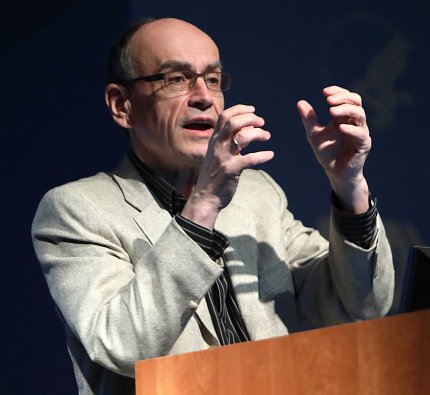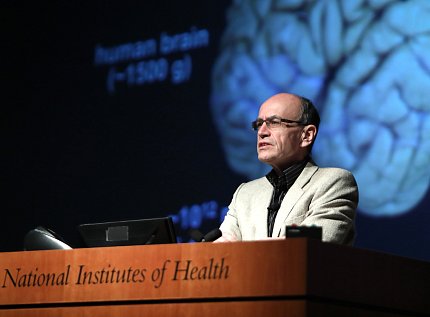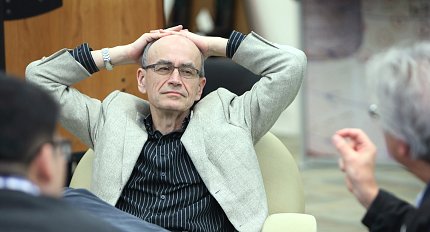Window on Brain
Südhof Explores Molecular Logic of Neural Circuits

Photo: Chia-Chi Charlie Chang
When a Nobel laureate comes to speak in Masur Auditorium, there is a flurry of pre- and post-synaptic activity, much of it having to do with audience members snapping cellphone pictures of the speaker.
Such was the case Jan. 31 when Dr. Thomas Südhof, who shared the 2013 Nobel Prize in physiology or medicine, discussed the molecular logic of synapse formation. There is growing evidence that impairments in the logic of neural circuits is associated with the development of autism, schizophrenia, Tourette’s syndrome and intellectual disability, he reported.
Now at Stanford, where he is a Howard Hughes Medical Institute investigator in the department of molecular and cellular physiology, Südhof focused on neurexins, cell-adhesion molecules crucial to the proper function of synapses.
Neurexins “come in two flavors, alpha and beta,” Südhof explained, “and there is a third form—gamma.” They are arguably the best-understood signaling molecules among a raft of them present when synapses form and do their jobs.
Especially interesting to Südhof is NRXN1, a large neurexin gene that, when mutated, is associated with more than 90 percent of common neuropsychiatric disorders. “But it is associated in a manner that we do not understand,” he said.
Südhof and his colleagues study how nerve cells are connected into networks via synapses. “We are looking for initial insights into how it works.

Photo: Chia-Chi Charlie Chang
“It always amazes me to consider how large the human brain is, with its vast, overlapping, interdigitated networks of trillions of synapses and billions of neurons,” he said. “Compared to the human genome, it is actually amazing how much bigger it is than the genome [the brain has ~1012 neurons and 1015 to 1016 synapses compared with the genome’s 4x109 base pairs of DNA and 22,000 genes]. It will be very difficult to find out how it works. This is arguably the most challenging goal we have now in biomedical research.”
Despite a wide variety in approaches to understanding the brain, Südhof said there is convergence on the importance of understanding neural circuits.
At their core are synapses, “specialized intercellular junctions…that form the fundamental computational unit of the brain. Not all of them are the same. Much depends on their location and history of connection. These differences are essential to understand how they are formed and specified. Synapse formation is a lifelong process with multiple components.”
Not yet clear is the molecular logic that guides synapse formation. “We don’t understand it at this point,” said Südhof, who nonetheless suspects that it follows “a classical cell-biological pathway.”

Photo: Chia-Chi Charlie Chang
Südhof and his colleagues are using human neurons derived from stem cells and mouse models with conditional mutations to characterize how mutations impair normal synaptic function. They are learning that the same mutation in different individuals causes different symptoms.
Among the threads to pull on: the most frequent single-gene mutation in schizophrenia involves NRXN1.
Südhof’s final slide put the role of neurexins as a tool for learning how the brain functions into sharp relief. It featured a Swiss Army knife, labeled Neurexin, with its multiple tools (“ligands”) extended.
“Neurexins contribute to the molecular logic that determines synapse properties,” he said. “They are central control switches. We can use them to dissect the molecular signals responsible for the activity and organization of synapses.”
A small red knife versus a 1,200-gram organ with trillions of synapses: ya gotta start somewhere.
